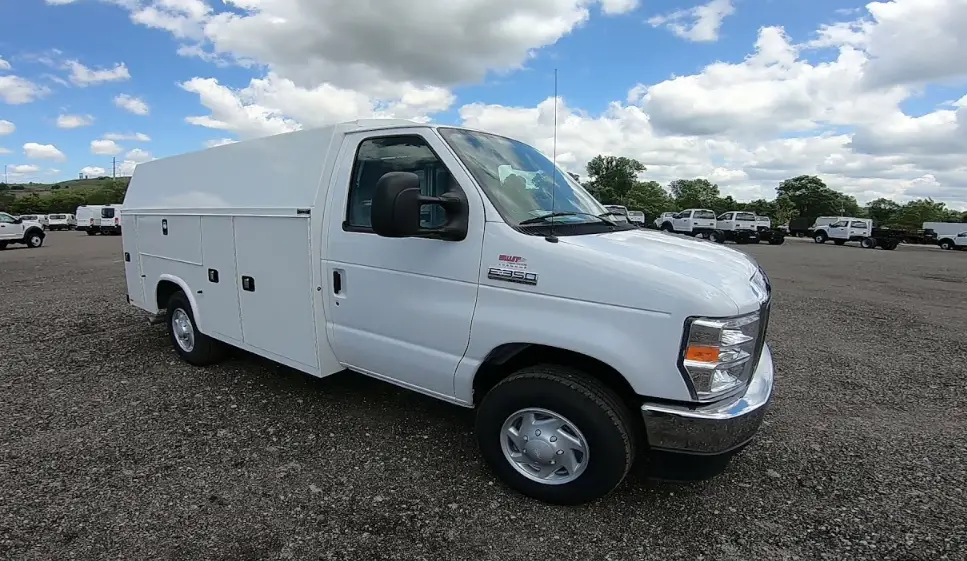2022 FORD E-350 Engine Oil and Fluids Information
The 2022 Ford E-350 runs reliably because of a thorough repair plan that focuses on engine oil and other important fluids. Engine oil is the vehicle’s heart. It makes sure that all the parts of the engine are properly lubricated and protected. The engine of the E-350 needs specific kinds of oil and regular oil changes to work well and last as long as possible. Other important fluids, like cooling, transmission fluid, brake fluid, and more, are just as important to a car’s operation as oil. These fluids work together to keep the engine at the right temperature, make gear changes smooth, improve how well the brakes work, and help the power steering. All of these carefully controlled fluids show how dedicated the 2022 Ford E-350 is to peak performance and the long-term health of its complex mechanical systems.
ENGINE OIL DIPSTICK

- A. MIN
- B. MAX
ENGINE OIL CHECK
- Make sure that your vehicle is on level ground.
- Check the oil level before starting the engine, or switch the engine off after warm-up and wait 10 minutes for the oil to drain into the oil pan.
- Remove the dipstick and wipe it with a clean, lint-free cloth.
- Reinstall the dipstick and make sure it is fully seated.
- Remove the dipstick again to check the oil level.
Note: If the oil level is between the maximum and minimum marks, the oil level is acceptable. Do not add oil. - If the oil level is at the minimum mark, immediately add oil.
- Reinstall the dipstick. Make sure it is fully seated.
Note: The oil consumption of new engines reaches its normal level after approximately 3,000 mi (5,000 km).
Adding Engine Oil
WARNING: Do not add engine oil when the engine is hot. Failure to follow this instruction could result in personal injury.
WARNING: Do not remove the filler cap when the engine is running.
Do not use supplemental engine oil additives because they are unnecessary and could lead to engine damage that the vehicle warranty may not cover.
- Clean the area surrounding the engine oil filler cap before you remove it.
- Remove the engine oil filler cap.
- Add engine oil that meets our specifications. See Capacities and Specifications .
- Reinstall the engine oil filler cap. Turn it clockwise until you feel a strong resistance.
Note: Do not add oil further than the maximum mark. Oil levels above the maximum mark may cause engine damage.
Note: Immediately soak up any oil spillage with an absorbent cloth.
Engine Oil Pressure Warning Lamp
WARNING: If it illuminates when you are driving do not continue your journey, even if the oil level is correct. Have your vehicle checked. It illuminates when you switch the ignition on.
It illuminates when you switch the ignition on.
If it illuminates when the engine is running this indicates a malfunction. Stop your vehicle as soon as it is safe to do so and switch the engine off. Check the engine oil level. If the oil level is sufficient, this indicates a system malfunction. Have your vehicle checked as soon as possible.
OIL CHANGE INDICATOR RESET
Base Cluster
Use the information display controls on the steering wheel to reset the oil change indicator.
From the main menu scroll to:
| Message | Action and Description |
| Driver assist | Press the right arrow button, then from this menu scroll down to the following message. |
| Maintenance Monitor | Press the right arrow button, then from this menu scroll down to the following message. |
| Oil Life % Hold to Reset | Press and hold the OK button until the instrument cluster displays the following message. Reset Complete |
| If the instrument cluster displays the following message, repeat the process. Reset Cancelled |
High Series Cluster
Use the information display controls on the steering wheel to reset the oil change indicator.
From the main menu scroll to:
| Message | Action and Description |
| Truck Info | Press the down arrow button, then from this menu scroll to the following message. |
| Maintenance Monitor | Press the OK button. |
| Oil Life: xxx% | Press the down arrow button, then from this menu scroll to the following message. |
| Oil Life | Press the OK button. |
| Oil Life Hold OK to Reset | Press and hold the OK button until the instrument cluster displays the following message. Oil Life: 100% |
| When the oil change indicator resets, the instrument cluster displays 100%. | |
| Repeat the process if the oil change indicator does not reset. |
CHANGING THE ENGINE AIR FILTER
WARNING: To reduce the risk of vehicle damage and personal burn injuries, do not start your engine with the air cleaner removed and do not remove it while the engine is running.
Note: Failure to use the correct air filter element may result in severe engine damage. The customer warranty may be void for any damage to the engine if the correct air filter element is not used.
When changing the air filter element, use only the air filter element listed. See Motorcraft Parts. The air filter element should be replaced at the appropriate intervals. See Normal Scheduled Maintenance.
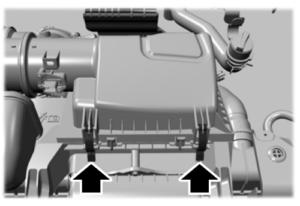
- Release the clips (x2) that secure the two halves of the air filter housing together.
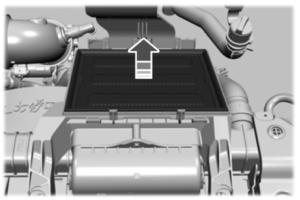
- Carefully separate the two halves of the air filter housing.
- Remove the air filter element from the housing.
- Install the new filter element. Be careful to put the filter seal on top of the tray, making sure that the seal is not pushed down into the tray. This could cause filter damage and allow unfiltered air to enter the engine if not properly seated.
- Install the air filter housing cover. Use special care to ensure that the air cleaner cover is reinstalled correctly. Verify that the tabs at the rear of the air cleaner housing cover are fully inserted into the slots at the rear of the air cleaner housing tray.
- Secure the air filter housing clips (x2).
ENGINE COOLANT CHECK
WARNING: Do not remove the coolant reservoir cap when the engine is on or the cooling system is hot. Wait 10 minutes for the cooling system to cool down. Cover the coolant reservoir cap with a thick cloth to prevent the possibility of scalding and slowly remove the cap. Failure to follow this instruction could result in personal injury.
WARNING: Do not put coolant in the windshield washer reservoir. If sprayed on the windshield, coolant could make it difficult to see through the windshield.
WARNING: To reduce the risk of personal injury, make sure the engine is cool before unscrewing the coolant pressure relief cap. The cooling system is under pressure. Steam and hot liquid can come out forcefully when you loosen the cap slightly.
WARNING: Do not add coolant further than the MAX mark.
When the engine is cold, check the concentration and level of the coolant at the intervals listed in the scheduled maintenance information. See Scheduled Maintenance.
Note: Make sure that the coolant level is between the MIN and MAX marks on the coolant reservoir.
Note: Coolant expands when it is hot. The level may extend beyond the MAX mark.
Maintain coolant concentration within 48% to 50%, which equates to a freeze point between -29°F (-34°C) and -35°F (-37°C). Coolant concentration should be checked using a refractometer. We do not recommend the use of hydrometers or coolant test strips for measuring coolant concentration.
Adding Coolant
WARNING: Do not add engine coolant when the engine is on or the cooling system is hot. Failure to follow this instruction could result in personal injury.
WARNING: Do not remove the coolant reservoir cap when the engine is on or the cooling system is hot. Wait 10 minutes for the cooling system to cool down. Cover the coolant reservoir cap with a thick cloth to prevent the possibility of scalding and slowly remove the cap. Failure to follow this instruction could result in personal injury.
Note: Automotive fluids are not interchangeable. Do not use coolant or windshield washer fluid outside of its specified function and vehicle location.
Note: Do not use stop leak pellets, cooling system sealants, or non-specified additives as they can cause damage to the engine cooling or heating systems. Resulting component damage may not be covered by the vehicle Warranty.
It is very important to use prediluted coolant approved to the correct specification in order to avoid plugging the small passageways in the engine cooling system. See Capacities and Specifications . Do not mix different colors or types of coolant in your vehicle. Mixing of engine coolants or using an incorrect coolant may harm the engine or cooling system components and may not be covered by the vehicle Warranty.
Note: If prediluted coolant is not available, use the approved concentrated coolant diluting it to 50/50 with distilled water. See Capacities and Specifications . Using water that has not been deionized may contribute to deposit formation, corrosion and plugging of the small cooling system passageways.
Note: Coolants marketed for all makes and models may not be approved to Ford specifications and may cause damage to the cooling system. Resulting component damage may not be covered by the vehicle Warranty.
If the coolant level is at or below the minimum mark, add prediluted coolant immediately.
To top up the coolant level do the following:
- Unscrew the cap slowly. Any pressure escapes as you unscrew the cap.
- Add prediluted coolant approved to the correct specification. See Capacities and Specifications .
- Add enough prediluted coolant to reach the correct level.
- Replace the coolant reservoir cap. Turn the cap clockwise until it contacts the hard stop.
- Check the coolant level in the coolant reservoir the next few times you drive your vehicle. If necessary, add enough prediluted engine coolant to bring the coolant level to the correct level.
If you have to add more than 1.1 qt (1 L) of engine coolant per month, have your vehicle checked as soon as possible. Operating an engine with a low level of coolant can result in engine overheating and possible engine damage.
Note: During normal vehicle operation, the coolant may change color, and slightly darken. As long as the coolant is clear and uncontaminated, this color change does not indicate the coolant has degraded nor does it require the coolant to be drained, the system to be flushed, or the coolant to be replaced.
In case of emergency, you can add a large amount of water without coolant in order to reach a vehicle service location. In this instance, qualified personnel:
- Must drain the cooling system.
- Chemically clean the coolant system.
- Refill with coolant that meets the correct specification. See Capacities and Specifications .
Water alone, without coolant, can cause engine damage from corrosion, overheating or freezing.
Do not use the following as a coolant substitute:
- Alcohol.
- Methanol.
- Brine.
- Any coolant mixed with alcohol or methanol antifreeze.
Alcohol and other liquids can cause engine damage from overheating or freezing.
Do not add extra inhibitors or additives to the coolant. These can be harmful and compromise the corrosion protection of the coolant.
Recycled Coolant
We do not recommend the use of recycled coolant as an approved recycling process is not yet available.
Dispose of used engine coolant in an appropriate manner. Follow your community’s regulations and standards for recycling and disposing of automotive fluids.
Severe Climates
If you drive in extremely cold climates:
- It may be necessary to increase the coolant concentration above 50%.
- A coolant concentration of 60%provides improved freeze point protection. Coolant concentrations above 60% decrease the overheat protection characteristics of the coolant and may cause engine damage.
If you drive in extremely hot climates:
- You can decrease the coolant concentration to 40%.
- Coolant concentrations below 40%decrease the freeze and corrosion protection characteristics of the coolant and may cause engine damage.
Vehicles driven year-round in non-extreme climates should use prediluted coolant for optimum cooling system and engine protection.
Coolant Change
At specific mileage intervals, as listed in the scheduled maintenance information, the coolant should be changed. Add prediluted coolant approved to the correct specification. See Capacities and Specifications.
Fail-Safe Cooling
Fail-safe cooling allows you to temporarily drive your vehicle before any incremental component damage occurs. The fail-safe distance depends on ambient temperature, vehicle load and terrain.
How Fail-Safe Cooling Works
If the engine begins to overheat, the coolant temperature gauge moves toward the red zone: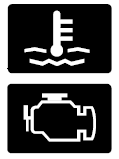 A warning lamp illuminates and a message may appear in the information display.
A warning lamp illuminates and a message may appear in the information display.
If the engine reaches a preset
over-temperature condition, the engine automatically switches to alternating cylinder operation. Each disabled cylinder acts as an air pump and cools the engine.
When this occurs, your vehicle still operates, however:
- Engine power is limited.
- The air conditioning system turns off.
Continued operation increases the engine temperature, causing the engine to completely shut down. Your steering and braking effort increases in this situation.
When the engine temperature cools, you can re-start the engine. Have your vehicle checked as soon as possible to minimize engine damage.
When Fail-Safe Mode Is Activated
WARNING: Fail-safe mode is for use during emergencies only. Operate your vehicle in fail-safe mode only as long as necessary to bring your vehicle to rest in a safe location and seek immediate repairs. When in fail-safe mode, your vehicle will have limited power, will not be able to maintain high-speed operation, and may completely shut down without warning, potentially losing engine power, power steering assist, and power brake assist, which may increase the possibility of a crash resulting in serious injury.
WARNING: Do not remove the coolant reservoir cap when the engine is on or the cooling system is hot. Wait 10 minutes for the cooling system to cool down. Cover the coolant reservoir cap with a thick cloth to prevent the possibility of scalding and slowly remove the cap. Failure to follow this instruction could result in personal injury.
Your vehicle has limited engine power when in the fail-safe mode, drive your vehicle with caution. Your vehicle does not maintain high-speed operation and the engine may operate poorly.
Remember that the engine is capable of automatically shutting down to prevent engine damage. In this situation:
- Pull off the road as soon as safely possible and switch the engine off.
- If you are a member of a roadside assistance program, we recommend that you contact your roadside assistance service provider.
- If this is not possible, wait a short period for the engine to cool.
- Check the coolant level. If the coolant level is at or below the minimum mark, add prediluted coolant immediately.
- When the engine temperature cools, you can re-start the engine. Have your vehicle checked as soon as possible to minimize engine damage.
Note: Driving your vehicle without repair increases the chance of engine damage.
Engine Coolant Temperature Management (If Equipped)
WARNING: To reduce the risk of crash and injury, be prepared that the vehicle speed may reduce and the vehicle may not be able to accelerate with full power until the coolant temperature reduces.
If you tow a trailer with your vehicle, the engine may temporarily reach a higher temperature during severe operating conditions, for example ascending a long or steep slope in high ambient temperatures.
At this time, you may notice the coolant temperature gauge moves toward the red zone and a message may appear in the information display.
You may notice a reduction in vehicle speed caused by reduced engine power in order to manage the engine coolant temperature. Your vehicle may enter this mode if certain high-temperature and high-load conditions take place. The amount of speed reduction depends on vehicle loading, grade and ambient temperature. If this occurs, there is no need to pull off the road. You can continue to drive your vehicle. The air conditioning may automatically turn on and off during severe operating conditions to protect the engine from overheating. When the coolant temperature decreases to the normal operating temperature, the air conditioning turns on.
If the coolant temperature gauge moves fully into the red zone, or if the coolant temperature warning or service engine soon messages appear in your information display, do the following:
- Pull off the road as soon as safely possible and shift the transmission into park (P).
- Leave the engine running until the coolant temperature gauge needle returns to the normal position. If the temperature does not drop after several minutes, follow the remaining steps.
- Switch the engine off and wait for it to cool. Check the coolant level.
- If the coolant level is at or below the minimum mark, immediately add prediluted coolant.
- If the coolant level is normal, restart the engine and continue driving.
AUTOMATIC TRANSMISSION FLUID CHECK
Have an authorized dealer check and change the transmission fluid and filter at the correct service interval. See Scheduled Maintenance.
Do not use supplemental transmission fluid additives, treatments or cleaning agents. The use of these materials may affect transmission operation and result in damage to internal transmission components.
Checking Automatic Transmission Fluid
For scheduled intervals of the fluid checks and changes, See Scheduled Maintenance . Your transmission does not consume fluid. However, if the transmission is not working properly, for example, if the transmission slips or shifts slowly, or if you notice some sign of fluid leakage, check the fluid level as soon as possible.
Automatic transmission fluid expands when warmed. To obtain an accurate fluid check, drive the vehicle until it is at normal operating temperature, approximately 19 mi (30 km). Verify that the transmission fluid temperature gauge on the instrument cluster is within normal range.
- Drive the vehicle 19 mi (30 km) until it reaches normal operating temperature.
- Park the vehicle on a level surface and engage the parking brake.
- With the engine running, parking brake engaged and your foot on the brake pedal, move the gearshift lever through all of the gear ranges. Allow sufficient time for each gear to engage.
- Put the transmission in park (P) and leave the engine running.
- Remove the dipstick, wiping it clean with a clean, dry, lint free rag.
- Install the dipstick, fully seating it in the filler tube.
- Remove the dipstick and inspect the fluid level. The fluid should be in the designated area for normal operating temperature or ambient temperature.
Low Fluid Level

E163740
Do not drive the vehicle if there is no indication of fluid on the dipstick and the ambient temperature is above 50°F (10°C).
Correct Fluid Level

E163742
Drive the vehicle 19 mi (30 km) or until it reaches normal operating temperature. Check the fluid at the normal operating temperature of 196°F (91°C) to 215°F (102°C) on a level surface.
High Fluid Level

E163744
Fluid levels above the safe range may result in transmission failure. An overfill condition of transmission fluid may cause shift and engagement concerns, and possible damage.
An overheating condition can cause high fluid levels.
Adjusting Automatic Transmission Fluid Levels
Note: Use of a non-approved automatic transmission fluid may cause internal transmission component damage.
Make sure to use the correct type of fluid. You can find the type of fluid used on the transmission dipstick, or in your owner’s manual. See Capacities and Specifications .
If necessary, add fluid in 8 floz (250 ml) increments through the filler tube until the level is correct.

E163746
If an overfill occurs, have a qualified technician remove excess fluid.
Note: An overfill condition of transmission fluid may cause shift and engagement concerns, and possible damage.
Do not use supplemental transmission fluid additives, treatments or cleaning agents. The use of these materials may affect transmission operation and result in damage to internal transmission components.
Automatic Transmission Fluid Filter

Your automatic transmission has a serviceable transmission fluid filter inside the transmission bottom pan. For service intervals for the automatic transmission fluid and transmission filter, See Scheduled Maintenance
For transmission filter maintenance, see your authorized dealer.
BRAKE FLUID CHECK
WARNING: Do not use any fluid other than the recommended brake fluid as this will reduce brake efficiency. Use of incorrect fluid could result in the loss of vehicle control, serious personal injury or death.
WARNING: Only use brake fluid from a sealed container. Contamination with dirt, water, petroleum products or other materials may result in brake system damage or failure. Failure to adhere to this warning could result in the loss of vehicle control, serious personal injury or death.
WARNING: Do not allow the fluid to touch your skin or eyes. If this happens, rinse the affected areas immediately with plenty of water and contact your physician.
WARNING: The brake system could be affected if the brake fluid level is below the MIN mark or above the MAX mark on the brake fluid reservoir.
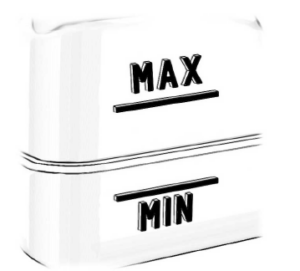
- Park your vehicle on a level surface.
- Look at the brake fluid reservoir to see where the brake fluid level is relative to the MIN and the MAX marks on the reservoir.
Note: If the brake fluid level is between the MIN and the MAX marks on the reservoir, it is acceptable.
Note: If the brake fluid level is below the MIN mark or above the MAX mark, have your vehicle checked as soon as possible.
Note: To avoid fluid contamination, the reservoir cap must remain in place and fully tight, unless you are adding fluid.
Only use fluid that meets our specifications. See Capacities and Specifications .
Brake Fluid Service Interval
Brake fluid absorbs water over time which degrades the effectiveness of the brake fluid. Change the brake fluid at the specified intervals to prevent degraded braking performance.
For detailed interval information, see Scheduled Maintenance in your Owner’s Manual or your local maintenance guide.
FAQs
A: The specific engine oil type and viscosity can vary based on the engine option and configuration. Refer to the owner’s manual for the correct oil specifications.
A: The recommended oil change interval can vary based on factors like driving conditions and engine type. The owner’s manual provides guidance on the appropriate oil change schedule.
A: Synthetic oil is often recommended for modern engines, including those in the 2022 Ford E-350. It provides better protection and performance in varying conditions.
A: The engine oil dipstick is usually located near the engine block, allowing you to check the oil level easily.
A: To check the oil level, ensure the vehicle is on level ground and the engine is turned off. Pull out the dipstick, wipe it clean, reinsert it, and then pull it out again to read the oil level.
A: Yes, the vehicle’s dashboard often includes a warning light that illuminates when the engine oil level is low.
A: Other important fluids to monitor include coolant, transmission fluid, brake fluid, power steering fluid, and windshield washer fluid.
A: While it’s best to use the same brand and type of engine oil, mixing different brands in an emergency is generally acceptable. However, it’s advisable to stick with the recommended oil type and consult a professional if uncertain.
A: Fluid check intervals vary. Some fluids, like coolant and transmission fluid, require less frequent checks than engine oil. Refer to the owner’s manual for guidance.
A: Coolant, also known as antifreeze, helps regulate engine temperature and prevents freezing or overheating.
A: It’s not recommended to use water alone as a coolant replacement. Water doesn’t provide the same level of freeze and corrosion protection as proper coolant.
A: Coolant replacement intervals can vary. Check the owner’s manual for recommendations, but a common interval is around every 2 to 3 years.
A: Transmission fluid lubricates and cools the transmission, allowing for smooth gear shifting and preventing friction-related damage.
A: Some vehicles have sealed transmissions that don’t require regular fluid checks. If your E-350 has a dipstick for the transmission, you can check the fluid level following the instructions in the owner’s manual.
A: When handling fluids, wear gloves and eye protection, and follow proper disposal procedures. Ensure the engine is cool before checking or adding fluids. If uncertain, consult the owner’s manual or a professional mechanic.
Useful Links
View Full PDF: 2022 FORD E-350 Owner’s Manual| Auto User Guide
2022 FORD E-350 Fuses Operation Instructions

